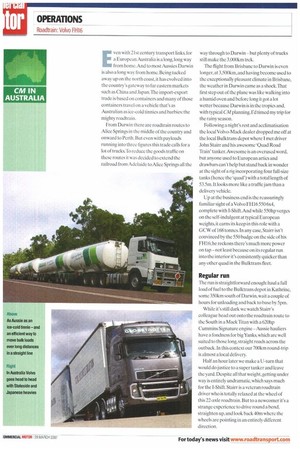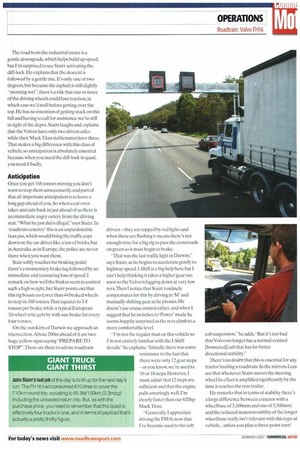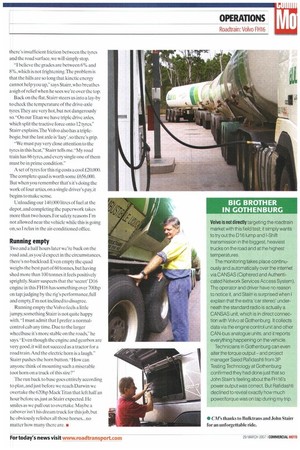E ven with 21st century transport links, for a European Australia
Page 44

Page 45

Page 46

Page 47

If you've noticed an error in this article please click here to report it so we can fix it.
is along, long way from home.And to most Aussies Darwin is also a long way from home. Being tucked away up on the north coast,it has evolved into the country's gateway to far eastern markets such as China and Japan .The import-export trade is based on containers and many of those containers travel on a vehicle that's as Australian as ice-cold tinnies and barbies: the mighty roadtrain.
From Darwin there are roadtrain routes to Alice Springs in the middle of the country and onward to Perth. But even with payloads running into three figures this trade calls for a lot of trucks.To reduce the goods traffic on these routes it was decided to extend the railroad from Adelaide to Alice Springs all the way through to Darwin—but plenty of trucks still make the 3,000km trek.
The flight from Brisbane to Darwin is even longer, at 3,500km, and having become used to the exceptionally pleasant climate in Brisbane, the weather in Darwin came as a shock.lhat first step out of the plane was like walking into a humid oven and before long it got a lot wetter because Darwin is in the tropics and, with typical CM planning, I'd timed my trip for the rainy season.
Following a night's rest and acclimatisation the local Volvo-Mack dealer dropped me off at the local Bulktrans depot where I met driver John Stain and his awesome 'Quad Road Train' tanker. Awesome is an overused word, but anyone used to European artics and drawbars can't help but stand back in wonder at the sight of a rig incorporating four full-size tanks (hence the 'quad') with a total length of 53.5m. It looks more like a traffic jam than a delivery vehicle.
Up at the business end is the reassuringly familiar sight of a Volvo FH16 5506x4, complete with I-Shift.And while 550hp verges on the self-indulgent at typical European weights, it earns its keep in this role with a GCW of 168 tonne& In any case, Stain isn't convinced by the 550 badge on the side of his FH16; he reckons there's much more power on tap —not least because on its regular run into the interior it's consistently quicker than any other quad in the Bulktrans fleet.
Regular run The run is straightforward enough: haul a full load of fuel to the Bulktrans depot in KathrMe, some 350km south of Darwin, wait a couple of hours for unloading and back to base by 5pm.
While it's still dark we watch Stain's colleague head out onto the roadtrain route to the South in a Mack Titan with a 620hp Cummins Signature engine—Aussie hauliers have a fondness for big Yanks, which are well suited to those long, straight roads across the outback. In this context our 700km round-trip is almost a local delivery.
Half an hour later we make a U-turn that would do justice to a super tanker and leave the yard. Despite all that weigh t,getting under way is entirely undramatic, which says much for the I-Shift.Stairr is a veteran roadtrain driver who is totally relaxed at the wheel of this 22-axle roadtrain. But to a newcomer it's a strange experience to drive round a bend, straighten up, and look back 40m where the wheels are pointing in an entirely different direction. The road from the industrial estate is a gentle downgrade, which helps build up speed, but I'm surprised to see Stain activating the duff-lock. He explains that the descent is followed by a gentle rise. It's only one or two degrees, but because the asphalt is still slightly "morning wet", there's a risk that one or more of the driving wheels could lose traction, in which case we'd stall before getting over the top. He has no intention of getting stuck on this hill and having to call for assistance: we're still in sight of the depot. Stain laughs and explains that the Volvos have only two driven axles while their Mack Titan stablemates have three. That makes a big difference with this class of vehicle, so anticipation is absolutely essential because when you need the diff-lock in quad, you need it badly.
Anticipation
Once you get 168 tonnes moving you don't want to stop them unnecessarily, and part of that all-important anticipation is to leave a long gap ahead of you. So when a car overtakes and cuts back in just ahead of us there is an immediate angry outcry from the driving seat."What he just did is illegal," says Stairr. In 'roadtrain country' this is an unpardonable faux pas, which would bring the traffic cops down on the car driver like a ton of bricks, but in Australia, as in Europe, the police are never there when you want them.
Stair softly touches the braking pedal; there's a momentary brake lag followed by an immediate and reassuring loss of speed. I remark on how well the brakes seem to control such a high weight, but Stairr points out that this rig boasts no fewer than 44 braked wheels to stop its 168 tonnes.That equates to 3.8 tonnes per brake, while a typical European 10-wheel artic gets by with one brake for every four tonnes.
On the outskirts of Darvvin we approach an interscction.About 200m ahead of it are two huge yellow signs saying "PREPARE TO STOP".These are there to advise roadtrain drivers — they are topped by red lights and when these are flashing it means there's not enough time for a big rig to pass the crossroads on green so it must begin to brake.
"That was the last traffic light in Darwin," says Stairr, as he begins to accelerate gently to highway speed. I-Shift is a big help here bull can't help thinking it takes a higher gear too soon so the Volvo is lugging down at very low revs.Then I notice that Stain routinely compensates for this by driving in 'IV' and manually shifting gear as he pleases. He doesn't use cruise control either, and when! suggest that he switches to Tower' mode he seems happily surprised as the revs climb to a more comfortable level.
"I'm not the regular man on this vehicle so I'm not entirely familiar with the I-Shift details," he explains."Initially there was some resistance to the fact that there were only 12 gear steps —as you know, we're used to 16 or 18 steps. However, I must admit that 12 steps are sufficient and that the engine pulls amazingly well. I'm clearly faster than our 620hp Mack Titan.
"Generally, I appreciate driving the FI-116, now that I've become used to the soft cab suspension,he add "But it's too bad that Volvo no longer has a normal-control [bonneted] cab that has far better directional stability."
There's no doubt that this is essential for any tractor hauling a roacitrain. In the mirrors I can see that whenever Stairr moves the steering wheel its effect is amplified significantly by the time it reaches the rear trailer.
He remarks that in terms of stability there's a large difference between a tractor with a wheelbase of 3,100mm and one of 5,500mm; and the reduced manoeuvrability of the longer wheelbase really isn't relevant with this type of vehicle.., unless you plan a three-point turn! We're now out on the open road, which is the roadtrain's natural environment. Stairr is cruising at a steady 95-100km/h and it all feels quite natural. I have to keep reminding myself that we're 50m ahead of the rear wheel with a gross weight of 168 tonnes.
Rail investment For long stretches we're driving alongside the recently completed railway from Darwin to Alice Springs, but we don't see a single train. "I know there are trains running," Stairr tells me. "There are two trains per week; one passenger and one freight. It's ridiculous, and I doubt it was really necessary to construct the two expensive bridges where the road crosses the railroad.But, it was a political decision to build the railroad, even though it's still us, with the trucks, who are freighting the goods."
We reach the only mountains on our route but Stairr knows exactly what to do. "If I don't activate the duff-lock, lengthwise as well as crosswise, we're not getting over.! forgot it once, and I'll not forget it again," he says, while concentrating on the seemingly endless climb. It's not at all a question of 600 or 700hp, or whether you have a 12 or 18-speed gearbox...if there's insufficient friction between the tyres and the road surface, we will simply stop.
believe the grades are between 6% and 8')/o, which is not frightening.The problem is that the hills are so long that kinetic energy cannot help you up," says Stairr, who breathes a sigh of relief when he sees we're over the top.
Back on the flat, Stainsteers us into a lay-by to check the temperature of the drive-axle tyres.They are very hot, but not dangerously so. "On our Titan we have triple drive axles, which split the tractive force onto .12 tyres," Stain explains.The Volvo also has a triplebogie. but the last axle is 'lazy'. so there's grip.
"We must pay very close attention to the tyres in this heat," Staintells me. "My road train has 86 tyres, and every single one of them must be in prime condition."
A set of tyres for this rig costs a cool £20,000. The complete quad is worth some £656,000. But when you remember that's it's doing the work of four allies, on a single driver's pay, it begins to make sense.
Unloading our 140,000 litres of fuel at the depot, and completing the paperwork takes more than two hours. For safety reasons I'm not allowed near the vehicle while this is going on, so I relax in the air-conditioned office.
Running empty
Two and a half hours later we're back on the road and, as you'd expect in the circumstances, there's no backload. Even empty the quad weighs the best part of 60 tonnes, but having shed more than 100 tonnes it feels positively sprightly. Stairr suspects that the 'secret' D16 engine in this FH16 has something over 700hp on tap; judging by the rig's performance, full and empty, I'm not inclined to disagree.
Running empty the Volvo feels a little jumpy, something Stairr is not quite happy with. "I must admit that I prefer a normalcontrol cab any time. Due to the larger wheelbase it's more stable on the roads," he says. "Even though the engine and gearbox are very good, it will not succeed as a tractor for a road train. And the electric horn is a laugh." Stainpushes the horn button."How can anyone think of mounting such a miserable toot horn on a truck of this size?"
The run back to base goes entirely according to plan, and just before we reach Darwin we overtake the 620hp MackTitan that left half an hour before us,just as Stain expected. He smiles as we pull out to overtake. Maybe a cabover isn't his dream truck for this job, but he obviously relishes all those horses... no matter how many there are.
























































































































































































